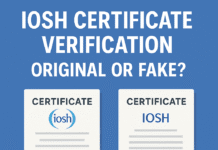
Near Miss Definition in IOSH
Near misses are incidents or situations where potential harm or damage could have occurred, but fortunately, they did not result in injury, illness, or damage to property. In the context of IOSH (Institution of Occupational Safety and Health), near miss incidents hold significant importance as they provide valuable opportunities for identifying and rectifying potential hazards before they escalate into more severe accidents. Understanding near misses and their implications within the framework of IOSH guidelines is crucial for fostering a safer work environment.
Importance of Identifying Near Misses
Recognizing near misses is essential for proactively managing workplace safety. While accidents often result in immediate consequences, near misses offer a chance to intervene before harm occurs. By identifying near miss incidents, organizations can implement corrective measures to prevent future accidents, thus mitigating risks and protecting both employees and assets.
Understanding Near Misses in IOSH
In IOSH, near miss incidents are defined as events that could have resulted in injury, illness, or damage but did not. IOSH emphasizes the importance of reporting near misses promptly to ensure thorough investigation and analysis. By understanding the root causes of near misses, organizations can address underlying safety issues and improve their safety protocols effectively.
Reporting Near Miss Incidents
IOSH encourages a culture of reporting near miss incidents without fear of retribution. Reporting mechanisms should be easily accessible to all employees, fostering transparency and accountability within the organization. Timely reporting allows for prompt investigation and implementation of corrective actions, reducing the likelihood of future accidents.
Analyzing Near Miss Data
Data analysis plays a crucial role in understanding patterns and trends related to near miss incidents. By analyzing near miss data, organizations can identify recurring hazards or systemic issues that require attention. This proactive approach enables targeted interventions to enhance safety measures and minimize risks effectively.
Implementing Preventive Measures
Based on the findings of near miss analyses, organizations can implement preventive measures to eliminate or mitigate identified hazards. This may involve updating safety protocols, providing additional training, or enhancing engineering controls. By addressing underlying issues proactively, organizations can create a safer work environment for all employees.
Training and Awareness Programs
Education and awareness are key components of near miss management in IOSH. Training programs should not only focus on identifying and reporting near misses but also emphasize the importance of proactive hazard identification and risk mitigation. By empowering employees with the knowledge and skills to recognize potential dangers, organizations can enhance their overall safety culture.
Near Misses and Safety Culture
Near miss reporting is closely linked to organizational safety culture. A positive safety culture encourages open communication, active participation, and continuous improvement in safety practices. By fostering a culture where near misses are viewed as opportunities for learning and improvement, organizations can create a workplace environment where safety is prioritized by all.
Legal Implications of Near Miss Reporting
In addition to ethical considerations, there may be legal obligations associated with near miss reporting in IOSH. Compliance with regulatory requirements and industry standards is essential for avoiding penalties and liabilities. By adhering to legal obligations related to near miss reporting, organizations demonstrate their commitment to safety and risk management.
Examples of Near Miss Incidents
Near miss incidents can encompass a wide range of scenarios, from potential equipment failures to unsafe work practices. Examples may include a scaffold that nearly collapses due to inadequate support, a chemical spill narrowly avoided due to prompt intervention, or a worker narrowly escaping injury from a falling object. These examples illustrate the diverse nature of near miss incidents and the importance of proactive hazard identification.
Comparison with Accidents
While near misses and accidents share similarities, they differ in their outcomes. Accidents result in actual harm or damage, whereas near misses represent close calls that could have led to harm but did not. Understanding the distinction between near misses and accidents is crucial for effective risk management and accident prevention.
Near Miss Reporting Challenges
Despite the benefits of near miss reporting, organizations may encounter challenges in encouraging reporting and ensuring follow-through on corrective actions. Common challenges include reluctance to report due to fear of blame or reprisal, lack of awareness about reporting procedures, and insufficient resources for addressing identified hazards. Overcoming these challenges requires proactive leadership, clear communication, and a commitment to continuous improvement.
Benefits of Near Miss Reporting
Despite the challenges, near miss reporting offers numerous benefits to organizations. By capturing near miss incidents, organizations can identify potential hazards early, leading to more effective risk mitigation strategies. Additionally, near miss reporting fosters a culture of safety and continuous improvement, enhancing employee morale and productivity.
Conclusion
Near miss incidents represent valuable opportunities for organizations to identify and address potential hazards before they escalate into more severe accidents. By fostering a culture of reporting and proactive risk management, organizations can create safer work environments and protect the well-being of their employees. Embracing near miss reporting not only enhances safety but also demonstrates a commitment to continuous improvement and excellence in occupational health and safety.
Top 10 IOSH Violations in 2024
IOSH Safety Manager Qualifications
IOSH Safety Engineer Qualifications
IOSH Scholarship for Safety Professionals
Unique FAQs
- What should employees do if they witness a near miss incident?
- Employees should report near miss incidents promptly using the designated reporting mechanisms. This allows for thorough investigation and implementation of corrective actions to prevent future accidents.
- How can organizations encourage a culture of near miss reporting?
- Organizations can encourage near miss reporting by promoting open communication, providing training on reporting procedures, and fostering a non-punitive reporting environment where employees feel comfortable sharing their experiences.
- Are near miss incidents less serious than accidents?
- While near miss incidents do not result in actual harm or damage, they are indicative of underlying hazards or unsafe practices that require attention. Addressing near misses proactively can help prevent more severe accidents in the future.
- What role does leadership play in near miss management?
- Leadership plays a crucial role in promoting a culture of safety and accountability within an organization. By demonstrating a commitment to near miss reporting and proactive hazard identification, leaders set the tone for safety excellence.
- How can organizations leverage near miss data to improve safety performance?
- Organizations can analyze near miss data to identify trends, patterns, and recurring hazards. This information can then be used to develop targeted interventions, enhance safety protocols, and prevent future accidents.
























